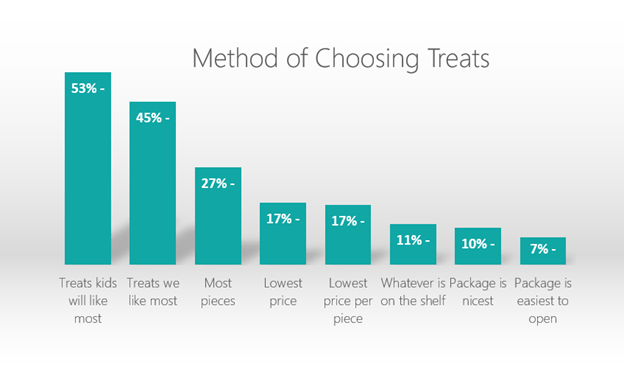During any holiday season, retailers need to understand the associated consumer behaviors and emotions in order to create marketing strategies that will have a positive impact on purchase behavior. When it comes to Halloween, that means understanding the unwritten rules of Halloween and the drivers of treat shopping.
In this shopper research study*, we asked nearly 700 adults across the USA to share their Halloween experiences with us. This year, about 57% of households intend to participate in Halloween Trick-or-Treating. In particular, households led by adults under the age of 45 (62%), with kids under the age of 6 (70%), or incomes greater than $100 000 (72%) are more likely to join in the festivities.
Let’s dive into the data to uncover insights about their Halloween shopping strategies, their unwritten rules of Halloween Trick-or-Treating, and the secrets kids need to know to end the evening with the fullest treat bag possible!
Halloween Consumer Shopping Strategies
Perhaps the most important part of Halloween is ensuring that the treat bucket at the front door is full and ready to dispense goodies to eager Trick-or-Treaters. For nearly 80% of shoppers, the path to purchase starts a few days up to a couple of weeks before Halloween. About 17% of people adhere to a just-in-time shopping model by waiting until the day before or the day of to buy their treats.
Nearly a third of people are price-conscious and buy treats whenever they are on sale. Those shoppers are more likely to be women, households with kids under the age of 6 years, or people whose annual household income is under $35,000.
Once people pull out their physical or digital wallets, about 51% spend from $15 to $39 on treats. However, about 17% are price-indifferent and spend more than $50. Those big spenders tend to be households with annual incomes greater than $50,000.
People are quite consistent about the kinds of treats they choose. Chocolates win (72%) and sweet candies are close behind (67%). Sour candies are also a preferred choice (41%) but salty snacks are far behind in fourth place (16%). Shoppers do account for kids who have special needs and many households are prepared with allergy-safe snacks (16%), small toys (14%), or healthy snacks (11%).
As you can see in the chart, the choice of which specific treat to buy is quite easy. People tend to buy treats they think kids will like the most (53%) followed closely by treats they themselves like the most (45%), perhaps hoping for leftovers! They’re not necessarily concerned about choosing a package with the lowest price per piece (17%) but, for the sake of simplicity, they do try to choose packages with more pieces (27%).

The Unwritten Rules of Halloween
There may be no formal rules dictating the structure of Halloween but we’ve built a shared cultural understanding of how the evening works.
Nearly 80% of people think kids can start Trick-or-Treating once they reach the age of 3 to 6 years. While most people think kids should stop trick-or-treating around the age of 15 (44%), you can see from the chart that more than 40% think that every age should be able to trick-or-treat. Does that gap mean there’s a future for adult-oriented treats on retail shelves?
Kids are welcome to start approaching doors around 5 to 6pm (55%) but they should head home around 9pm (33%). About 13% of people think it’s okay to Trick-or-Treat as late as 11pm or midnight, but that’s mainly households with 18 to 34-year-olds. Since that’s quite late, Trick-or-Treaters should only visit homes where the front door light is on (80%). Even better, they should make sure there’s a carved pumpkin out front (36%) or some spooky music playing (27%) as well.
It’s good to know that most people think that kids should receive 2 or 3 treats from each household (56%), but there’s a healthy minority (14%) who are quite generous in giving a handful to each kid.

Halloween Tricks for Treaters
Now it’s time to think about the kids! For those caregivers who want to ensure their little skeletons, Barbies, and Kens come home with treat bags as full as possible, here are some tips to consider!
First, head to neighborhoods where the households have moderate to higher incomes, perhaps over $50,000. These households are more likely to spend more than $50 buying treats. Then, focus on homes with the lights on, the door open, a pumpkin on display, AND music playing or extra decorations. These households love Halloween and want their creepy guests to enjoy the evening as much as possible.
Finally, to receive a full handful of treats rather than just 1 piece, look for households led by 25 to 34 year olds, or earning a modest income, regardless of whether they have kids. They’re still young and young at heart, ready to fill those bags!
From Consumer Behaviors to Strategies
Behind every purchase is a shopper mindset grounded in cultural norms and personal emotions. Gathering the right set of consumer data to understand those shoppers is critical for creating a more personal and enjoyable retail experience. Explorer’s experts have the deep knowledge and tools required to help you understand these shoppers, optimize your shopper strategies, and create activations that drive sustained growth. Get in touch with us to explore your range of opportunities.
*Note: In October 2023, 676 adults from across the USA were recruited from a non-probability access panel to complete a 10-minute self-administered questionnaire. As with all non-probability samples using access panels, margin of error cannot be calculated and the results are subject to both sampling and non-sampling error.


